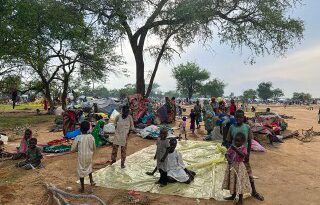Debunking Myths: Muslim Kings in India brought Islam by Sword, demolished Temples
by Imtiaz Ahmed
Manabendra Nath Roy states, “ Islaam came to India after it had played out its progressive role, and leadership had been wrested from the learned and cultured Arabs…”
Recording history in the written form had never been an Indian tradition. It was introduced into India by the Muslims of the Middle-East, Central Asia and Persia and later systematized by the West Europeans.
The lack of unbiased, factual records has abetted speculations and misconceptions about the role of Muslims in the Indian Subcontinent [before the struggle for Independence]. In view of the contemporary political situation, it is vital Muslims and non-Muslims conduct a dispassionate and incisive study of Islaam in India, from its heyday in the Medieval period till the time of Colonial domination by the British to set right the records.
A fair and just appraisal of the history of Islaam in the Indian Subcontinent—from the early inroads into Sindh in the eighth century, to the establishment of the Delhi Sultanate in the thirteenth century, and through the Middle Ages up to the present day—requires detailed and dispassionate investigation, says modern historian and scholar Raziuddin Aquil.
An unquestionable fact is, Muslims and Islaam did not always announce their arrival in a particular region with widespread bloodshed. Compared to the violent irruptions of the Mongols and other political conquests during Medieval times, the Turkish invasion of Hindustan and the advent of the Mughals did not result in large scale violence and demographic dislocations.
Indian revolutionary political theorist, Manabendra Nath Roy states, “ Islaam came to India after it had played out its progressive role, and leadership had been wrested from the learned and cultured Arabs…”
The Western seaboard of India was known to sea-faring Arab traders long before the advent of Islaam. Islaam as a religion and presumably, a way of life may have been established by the Indo-Arab communities within the living memory of the Prophet Mohammed himself, and in the year 712 A.D., during the reign of second caliph Umar ibn al-Khattaab, Islaam reached India.
The emergence of Muslims as a community took place in stages. Initially, the Arabs who came to trade during the 7th century in the Malabar coast, exerted a powerful influence on the local people by their fair trade practices and behavior and many people embraced Islam. Whereas, the Arab army that conquered Sindh early in the 8th century, had only a marginal impact on society as far as conversions were concerned.
With the Turkish invasion, during the 11th and 12th centuries, the influence of Islaam became more widespread. Initially this was restricted to the emerging Muslim military aristocracy. Some of the converts came from the Hindu upper-classes, either out of conviction, or in the hope of reward from the Muslim ruler. But soon, the main conversions came from the poor low caste untouchables, who, despite belonging formally to the Hindu fold, were oppressed by the upper caste Brahmins.
To quote from Vivekanand: ‘Why amongst the poor of India so many are Mohammedans? It is nonsense to say that they were converted by the sword, it was to gain liberty from zamindars and priests…’
Conversion was generally not the objective of conquering kings (except Ashoka). The Mughal Rulers did not disturb or interfere with the social structure in their dominions. Their courts had a large number of Muslim as well as Hindu courtiers, Rajas and Zamindars. But they are viewed so differently from the Hindu rulers of the age. The Hindu kings who fought for the preservation and expansion of their own personal dominion against the Muslim empire, are projected as ‘national heroes’: Shivaji, Rana Pratap, Guru Gobind Singh, while the Muslim rulers are projected as national enemies.
Many of these Hindu kings and their descendants allied with Mughal Rulers: e.g. Rana Pratap’s son Amar Singh developed a friendship with Jahangir; in the later period, Guru Gobind Singh came to an agreement with the Mughal ruler. Their only intent, like the Muslim rulers of the age was to preserve their power in their kingdoms- not to build an Indian nation, a process that began much later.
Babar’s Will:
Son, this nation Hindustan has different religions. Thank Allah for giving us this kingdom. We should remove all the differences from our heart and do justice to each community according to its customs. Avoid cow-slaughter to win over the hearts of the people of this land and to incorporate the people in the matters of administration. Do not damage the places of worship and temples, which fall in the boundaries of our rule. Evolve a method of ruling whereby all the people of the kingdom are happy with the king and the king is happy with the people.
Islam can progress by noble deeds and not by terror. Ignore the differences of Shia & Sunni as this is the weakness of Islam. Keep the people following different customs integrated into a single whole so that no part of this kingdom becomes diseased. [Translated from the original at national Museum, New Delhi]
This statement is clear evidence that Babur would not have destroyed the Ram Mandir to build a Babri Masjid.
Did Muslim Kings destroy the Hindu Temples to humiliate Hindu religion and to spread Islam?
Temple have always been repositories of wealth . Temples were plundered by kings irrespective of their religion. Religion was the ideological fig leaf to justify desecration. Temples were plundered by the Marathas in Tipu’s Sultanate. The Shri Rangapatnam Temple was destroyed by the Maratha armies and was repaired by Tipu Sultan.
Attacking temples was also a way of humiliating other kings.
The famous temple of Somnath was looted by Muhammad Ghazni. His main aim was to loot the huge quantities of gold kept in the temple. On his way to Somnath, he first had to fight with Muhammed Fath Dawood and in the process, the mosque of Multan was damaged.
He allied with Anandpal, the ruler of Thaneshwar, before attacking the temple. Many of his army generals, Tilak, Sondhi, Rai Hind, and Harzan were Hindus and a substantial part of his army comprised of Hindu soldiers. Later, his son sent his army to destroy a mosque in central Asia.
Temples were looted by King Harsha of Kashmir in the 11th century. Mention of this is in Kalhan’s book ‘Rajtarangiri’ which states that he appointed a special officer to uproot the golden idols from the temples. This officer was designated as devotpatan nayak (officer who uproots the Gods).
The Parmar King (Shubhatvarman 1193-1210 a.d.) destroyed Jain temples in Cambay and Dabhoi in addition to plundering temples in his own kingdom.
Often portrayed in bad light in history with regard to his attitude towards Hindus as desecrator of a number of Hindu temples, Aurangazeb not only destroyed temples and masjids, he also gave jagirs to many temples. States historian Audrey Truschke , in her new book: ‘Aurangzeb: The Man and the Myth’, : “Hindu and Jain temples dotted the landscape of Aurangzeb’s kingdom.”
Documents at the Vrindavan Research Centre show that Akbar, Jahangir and Shahjahan too gave a number of jagirs to these temples.
Religious institutions were entitled to Mughal state protection, and Aurangzeb generally endeavored to ensure their well-being. But, by the same token, from a Mughal perspective, that goodwill was revoked when specific temples or their associates acted against imperial interests. Then, Emperor Aurangzeb authorized targeted temple destructions and desecrations throughout his rule.
Demolition of the Kashi Vishwanath Temple by Aurangazeb
While Aurangazeb was passing near Varanasi on his way to Bengal, the Hindu rajas in his retinue requested that they halt for the day, so that their ranis could go to Varnasi, take a dip in the Ganges and pay their homage to Vishwanath.
Aurangazeb readily agreed and army pickets were posted on the five mile route to Varnasi. The ranis made the journey in palkis. They took their dip in the Ganges and went to the Vishwanath temple to pay homage. After offering puja, all the ranis returned, except one, the Maharani of Kutch. A thorough search was made of the temple precincts, but the Rani was nowhere to be found.. When Aurangazeb came to know about it, he was enraged. He sent his senior officers to search for the Rani.
Finally, they found that the statue of Ganesh which was fixed in the wall was a movable one. When they moved the statue, they discovered a flight of stairs that led to the basement. To their horror, they found the missing Rani there, dishonored and crying. The basement was just beneath Vishwanath’s seat.
The rajas expressed their protests vociferously. As the crime was heinous, the rajas demanded exemplary action. Aurangazeb ordered that as the sacred precincts had been despoiled, idol of Vishwanath should be moved elsewhere, the temple be razed to the ground and the mahant be arrested and punished.
This evidence of history has been confirmed by the erstwhile curator of the Patna museum, Dr. PL Gupta [Asghar Ali Engineer 1995, Communalism in India. New Delhi : Vikas Publishing House.]
Aurangzeb carried on the traditions of his forefathers in granting favours to Hindu religious communities, a continuity underscored by his dealings with the Jangam, a Shaivite group.
The Jangam benefited from Mughal orders beginning under Akbar, who confirmed their legal rights to land in 1564. The same Jangam received several farmans from Aurangzeb that restored land that had been unfairly confiscated (1667), protected them from a disruptive local Muslim (1672), and returned illegally charged rent (1674).
Mughal rulers including Aurangazeb had a very liberal policy towards the Mathura-Vrindavan region where a number of places of pilgrimage are located. The documents available with the Vrindavan Research Centre show that Akbar, Jahangir and Shahjahan gave a number of jagirs to these temples.
There is nothing to justify the belief that the Muslim Kings destroyed Hindu temples to convert Hindus to Islam. ‘How can one think that the way of winning over people’s hearts is to go and demolish temples?…’
-Harbans Mukhia (1994)Medieval History and Communal Approach. New Delhi: Peoples’ Publishing House.]
I conclude by quoting the great Indian personality Maulana Abul Kalam Azad, the distinguished Muslim leader who served twice as the President of the Indian National Congress. He declared in 1940: “I am a Muslim and profoundly conscious of the fact that I have inherited Islaam’s glorious traditions of the last thirteen hundred years. I am not prepared to lose even a small part of that legacy…I am equally proud of the fact that I am an Indian, an essential part of the indivisible unity of Indian nationhood, a vital factor in its total make-up without which this noble edifice will remain incomplete. I can never give up this sincere claim.” [see Hameed 1990:161]
Imtiaz Ahmed is a lecturer and a writer. He is also an instructor at Chennai-based Illume Academy. He regularly tweets under @imti131.



